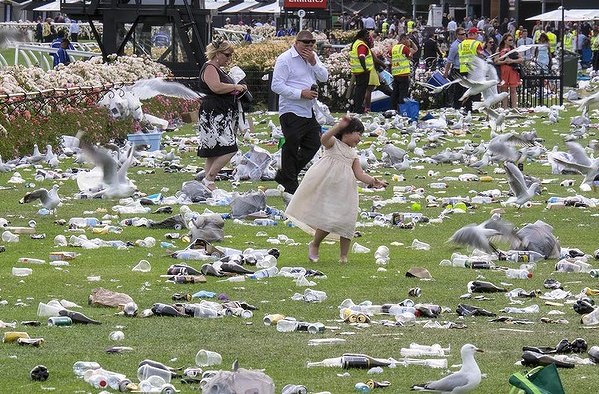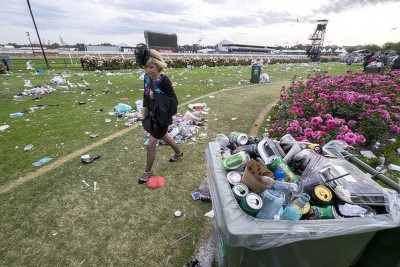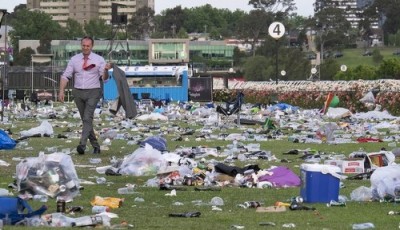We are drowning.
That’s what it thought when I saw these pictures, and that’s when the words by Edwin Louis Cole quoted in the title came into my mind.
I also remembered that not too long ago, I got upset when I witnessed one plastic bag flying around on the beach that nobody would pick up.
One plastic bag.
Ha!
That little rant was harshly put into perspective when I saw these pictures taken by photographer Luis Ascui after the Melbourne Cup, Australia’s major horse race, which is fondly referred to as “the race that stops the nation.”
Well, a few more of these and the nation is not going anywhere anymore, indeed.
It will be buried under its own rubbish. Drowned in its own non-recycled garbage. Overrun by swarms of rapacious seagulls who will not be able to distinguish between the trash and the trashers.
It made me ponder a couple of issues on human behaviour that I cannot wrap my brain around.
First of all, there is the observation that at large events like the Melbourne Cup, where thousands of people gather to overindulge, binge and display all sorts of excessive behaviour, the standard of civilisation seems to drop radically.
Suddenly, it’s quite normal to throw empty bottles on the ground, leave half eaten hamburgers lying around on the grass and walk around with high heels and feathered hats through piles of litter.
The slums of Mumbai are probably cleaner than this, and I dare say that these ladies would probably not venture out there in their fancy dresses, because “it’s sooo dirty.”
Do we do this at home? Do we leave our leftovers and empty bottles on our lawn after a picnic in the garden? Do we throw our cigarettes butts on the floor when we’re dining at a friends house?
Why then, when en masse, do we suddenly forget all our manners? Why is it suddenly acceptable to pollute our own public space?
I know that a large part of the responsibility lies with the event organisors who need to supply enough containers, dumpster, bins and ashtrays.
Yet, if we look closely, we see plenty of bags and cool boxes left behind too, which means that the visitors brought their drinks and food in.
What then, I ask myself, is the problem with taking that same, much lighter plastic bag or cool box with empty bottles and empty food packaging with us on the way out?
Take it home, to the glass container, to the plastic recycling bin. Whatever. Just don’t leave it out there to be blown away by the wind, to be eaten by the birds who will die of toxic constipation or to be cleaned up by public services, which are payed for with tax money that everybody complains about having to pay.
Secondly, these images make me realise, once again, how much waste we create in general.
Documentaries like Wasteland or about the garbage island in the North Pacific Gyre depict the scale of the pollution we are generating on a daily basis—every bottle of soft drink we open, every candy we unwrap, every product we buy that is boxed and wrapped in plastic.
We are in it neck deep. We swim in it. We breath it. We eat and drink it. It’s everywhere, even if we don’t see it.
And even when we do see it, we don’t do anything about it.
I will never forget the day in 2003 that I was sailing on the Mekong river, travelling from Vietnam to Cambodia. Along the shores, in between the water bungalows of the villagers (not your average five-star Maldivian resort water villas, I assure you), there were trees with branches dipping in the water. From afar, it looked like the trees had been beautifully decorated with colourful garlands at the tip of the low hanging branches. It reminded me of Christmas.
As we sailed closer to shore, my heart sank into my flip flops. I realised this was no decoration. It was low tide and the rainbows in the trees were made out of plastic bags. Hundreds, thousand, perhaps millions of plastics bags that had been floating in the Mekong River and gotten entangled in the branches of the trees.
What I saw hanging in the trees was not a festive symbol anymore. It was now a toxic burden, suffocating the trees that in earlier times had been nurtured by the river.
I knew that these trees would never be unsullied again, the river never pure.
It made me feel nauseous.
The pictures of the Melbourne Cup made me feel exactly the same. Because I do not understand how we allowed ourselves to get here, and even more so, I do not know how we will ever be able to stop, let alone reverse, the damage we are doing to our beautiful planet and to ourselves.
We are slowly drowning.
Love elephant and want to go steady?
Sign up for our (curated) daily and weekly newsletters!
Author: Yaisa Nio
Editor: Emily Bartran
Photos: With permission from Luis Ascui














Read 1 comment and reply